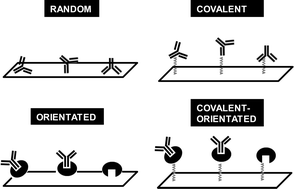Antibody immobilization strategies (random, covalent, orientated and combinations of each) were examined to determine their performance in a surface plasmon resonance-based immunoassay using human fetuin A (HFA) as the model antigen system. The random antibody immobilization strategy selected was based on passive adsorption of anti-HFA antibody on 3-aminopropyltriethoxysilane (APTES)-functionalized gold (Au) chips. The covalent strategy employed covalent crosslinking of anti-HFA antibody on APTES-functionalized chips using 1-ethyl-3-[3-dimethylaminopropyl]carbodiimide (EDC) and sulfo-N-hydroxysuccinimide (SNHS). The orientation strategy used passive adsorption of protein A (PrA) on Au chips, with subsequent binding of the anti-HFA antibody in an orientated fashion via its fragment crystallisable (Fc) region. In the covalent-orientated strategy, PrA was first bound covalently, to the surface, which in turn, then binds the anti-HFA antibody in an orientated manner. Finally, in the most widely used strategy, covalent binding of anti-HFA antibody to carboxymethyldextran (CM5-dextran) was employed. This immobilization strategy gave the highest anti-HFA antibody immobilization density, whereas the highest HFA response was obtained with the covalent-orientated immobilization strategy. Therefore, the covalent-orientated strategy was the best for SPR-based HFA immunoassay and can detect 0.6–20.0 ng/mL of HFA in less than 10 min.

You have access to this article
 Please wait while we load your content...
Something went wrong. Try again?
Please wait while we load your content...
Something went wrong. Try again?


 Please wait while we load your content...
Please wait while we load your content...